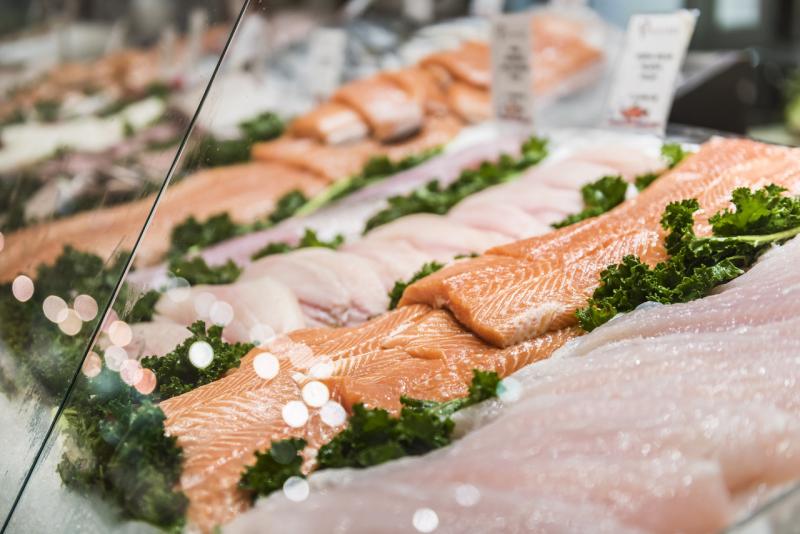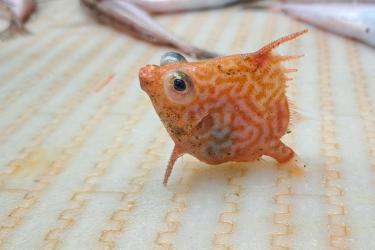Cheryl Lassitter oversees testing for chemical contaminants at the National Seafood Inspection Laboratory. She’s worked as a chemist for around 30 years—14 years at the lab—and has seen important advancements in analytical testing during that time. She enjoys working with and learning software algorithms as well. She is active in scientific groups such as the American Association of Analytical Communities and the National Shellfish Sanitation Program.
What chemicals does the lab test for?
When we test products, we’re looking for contaminants such as bisulfites, histamines, and veterinary drugs. We now also test for trace metals. We have new instrumentation to detect an entire suite of important trace metals, such as Cadmium, in seafood.
Veterinary drugs are found in farm-raised seafood. They are the antibiotics and antimicrobials used in the aquaculture industry. Like metals, these can build up in the tissues of fish and shellfish while they are alive.
Sulfites are added to shrimp and other shellfish products during product handling following harvest. Shrimp catchers, for example, will add sulfites to their catch. This prevents the shrimp from developing blackspots and turning brown, which makes them less marketable. Some people are allergic or have a sensitivity to bisulfites, so we test the levels of these added chemicals to ensure they aren’t too high.
Why look for those chemicals specifically?
Many of our samples are sent to us by NOAA Fisheries’ Seafood Inspection Program on a predetermined schedule. We test those for specific chemicals that are potential food safety hazards in seafood products. The program is a fee-for-service program, which helps ensure participating commercial seafood operations comply with seafood regulations.
The lab is also a resource for researchers, government agencies, and others to conduct specially requested tests. That work is part of our mission to support food safety and chemical research and inform the public about the state of seafood contaminants. For example, we recently completed a project for NOAA Fisheries Southwest Fisheries Science Center involving the analyses of mercury and selenium in opah samples.
What instruments do you use to test for these chemicals?
We use kits to test for two veterinary drugs—chloramphenicol and nitrofuran—and a kit for histamine analysis as well. The lab also has two sophisticated mass spectrometer instruments to help us better detect both veterinary drug residues and heavy metals, when this is required. We use these instruments to detect chemicals in a sample and measure their molecular or atomic masses. The mass spectrometer that we use to measure metals, such as Cadmium, is a separate, dedicated instrument. The mass spectrometer used for veterinary drugs also detects pesticides and important marine biotoxin molecules—toxins made by algae—such as saxitoxin and domoic acid.
We have a more complex “wet” analysis method to detect bisulfites.
How have testing methods changed over the course of your career?
Instruments and supplies have become more user-friendly, faster, and more sensitive. This includes simple kits for highly sophisticated molecular or atomic detection instruments.
The gas chromatography technique is one example of technical advances. Similar to mass spectrometry, we use this technique to separate and measure individual chemical compounds. The gas chromatographs we have today are designed to recognize the specific chemicals we’re looking for and convert their concentrations into electronic signals. It then interprets the signals on a specialized software platform. The software is calibrated to show a response of the presence of specific chemicals based on chemical signal “peaks.”
In earlier gas chromatography analysis, the instrument would identify the peaks, but chemists had to manually calculate the mass of individual chemical components. This could span long periods of time, where the results are instantaneous now.
What do these instrument advancements mean for seafood consumers?
They allow us to detect chemical contaminants rapidly and more efficiently, and at much lower thresholds than before. These technological advances translate into higher quality and faster results for the general public and vital stakeholders.
What’s an example of a research project your team is working on?
We are currently analyzing samples to create a large database for a domestic seafood market survey project. With help from a subcontractor, we’ve collected about 1,000 seafood product samples from 100 different species. We are testing each of those samples to document various parameters—mercury and selenium levels, total metals, presence of veterinary drugs, moisture concentration, etc.
When it’s complete, the project will paint a general picture of contaminant chemical levels in the primary species that make up the commercial seafood market. That will allow us to compare and contrast contaminant concentrations across species. We’ll also be able to investigate how the parameters impact one another. For instance, how is the concentration of mercury affected by the concentration of another selenium? Does the moisture concentration of a seafood product affect the mercury/selenium relationship? We believe that providing this background data and addressing these questions will be beneficial to the academic community, regulatory agencies, and the public at large.




